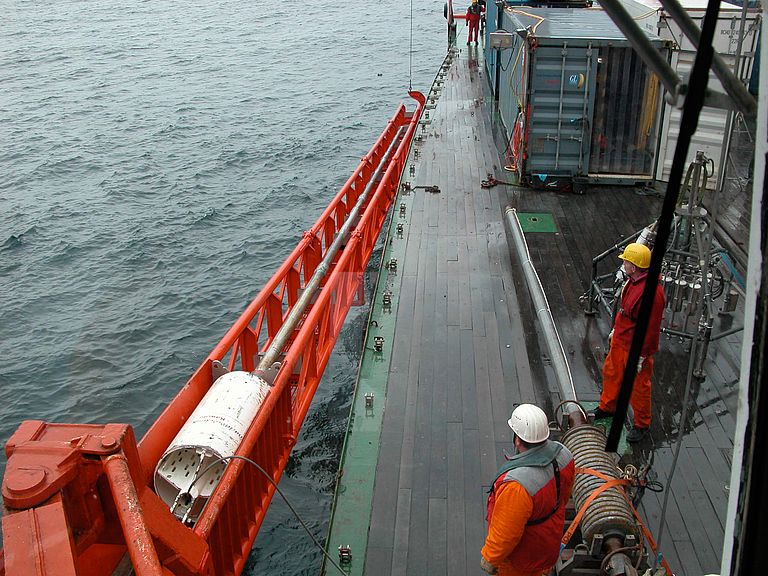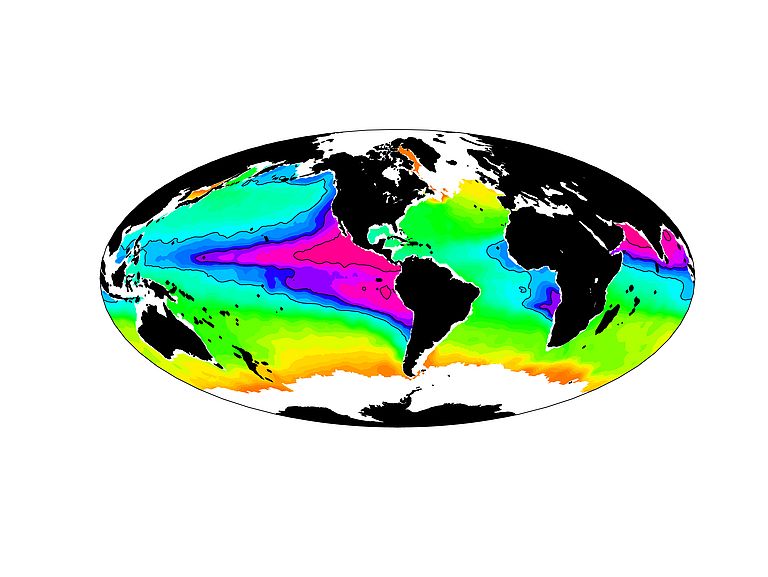Does the Release of Iron from Sediments Promote Oxygen Depletion in the Tropical Ocean?
Scientists in Kiel identify additional processes in oxygen minimum zones
The term "dead zones", frequently used for oxygen minimum zones, is, in fact, misleading. These zones, which to some degree exist in all tropical oceans, are actually caused by an abundance of nutrients and algal plankton thrives well in these regions. Only when bacteria break down the biomass thus produced, they consume large quantities of oxygen and there is hardly any left for larger animals, such as fish.
Iron is among the most important nutrients for phytoplankton. It mostly stems from sediments that are washed into the sea from the continent as the result of erosion. "How much iron is ultimately available for the planktonic organisms, however, also depends on the oxygen content of the seawater. This is due to the fact that oxygen binds iron, forming iron oxide minerals, which, similar to rust, cannot be processed by the plankton”, says Dr. Florian Scholz from GEOMAR Helmholtz Centre for Ocean Research Kiel. The less oxygen present, the more iron should therefore be available as a nutrient in seawater. Together with colleagues from the Kiel Collaborative Research Center 754 "Climate - Biogeochemistry Interactions in the Tropical Ocean", as well as colleagues from the USA, the geochemist has been studying the oxygen minimum zone off Peru to validate whether or not the relationship is that simple. The study is published in the current issue of the international journal "Nature Geoscience."
The researchers examined sediment samples from the waters off Peru, which were taken via the German research vessel METEOR during an expedition of the SFB 754. They then used a novel combination of paleo-environmental indicators. "The ratio of the concentrations of the trace elements molybdenum and uranium and the respective iron concentration in the sediment allows us to draw conclusions about how much iron was released from the sediment at a specific time", explains Dr. Scholz. This approach allows a reconstruction of the iron budgets over the past 140,000 years.
In the course of the investigation the scientists found that especially during periods of extremely low oxygen concentration, very little iron was released from the sediment. For it is precisely during these phases that many sulphur compounds are present in the upper layers of the sediment with which the iron can form iron sulfide minerals, before ever being released into the water. "Therefore the iron is not available for the microorganisms in the water", explains Dr. Scholz.
This result is of particular importance, since observations and modelling studies show the oxygen minimum zones in the tropical oceans to expand as a result of climate change and their intensity to increase. "Our research shows that a further expansion of the oxygen minimum zone off Peru does not automatically lead to greater availability of iron and thus to a self-reinforcing cycle", states Dr. Florian Scholz, who is currently working within the framework of the EU project BICYCLE at Oregon State University in Corvallis (Oregon, USA), where he investigates further details of the iron cycle in the oxygen minimum zones. "Only if we understand all biological, chemical and physical interactions in these highly complex systems, our colleagues can reliably model how they will continue to evolve during the course of climate change", the geochemist emphasizes.
Background information: The SFB 754
The Collaborative Research Centre 754 (SFB 754) "Climate-Biogeochemistry Interactions in the Tropical Ocean" was established in January 2008 as cooperation between the Christian-Albrechts-University Kiel (CAU), the GEOMAR Helmholtz Centre for Ocean Research Kiel and the Max-Planck-Institute Bremen. The SFB 754 explores the changes of oceanic oxygen content, the possible effects on the oxygen minimum zones and the consequences on the global interplay of climate and biogeochemistry of the tropical oceans. The SFB 754 is funded by the German Research Foundation (DFG) and is currently in its second phase (2012-2015).
Original publication:
Scholz, F., J. McManus, A. C. Mix, C. Hensen, R. R. Schneider (2014): The impact of ocean deoxygenation on iron release from continental margin sediments. Nature Geoscience, Advance Online Publication, dx.doi.org/10.1038/ngeo2162
Links:
www.sfb754.de Collaborative Research Centre 754
http://www.geomar.de/en/research/ongoing-projects/project-details/prj/2278/ The EU-Project BICYCLE (Benthic Iron Cycling in Oxygen Minimum Zones and Implications for Ocean Biogeochemistry)
Images in high resolution:
Use of a piston corer aboard R/Vl METEOR to recover the sediment cores off the coast of Peru used in the recently published study. Photo: Dirk Nürnberg, GEOMAR
Piston corer (left) are somewhat more complicated to use than normal gravity corers (right), but the sediment layers remains mostly intact. Photo: Dirk Nürnberg, GEOMAR
Map of the oxygen minimum zones in the tropical oceans (blue to purple). The current study is based on samples from the OMZ off Peru. Graphics: SFB 754
Contact:
Dr. Florian Scholz (GEOMAR, RD2 – Marine Geosystems, currently College of Earth, Ocean, and Atmospheric Sciences, Oregon State University), fscholz(at)geomar.de
Jan Steffen (GEOMAR, Communication & Media), Tel.: (+49) 0431 600-2811, jsteffen(at)geomar.de
![[Translate to English:] Einsatz eines Kolbenlots auf dem Forschungsschiff METEOR. Mit einem derartigen Lot wurden vor der Küste Perus die Sedimentkerne gewonnen, die als Grundlage der jetzt veröffentlichten Studie dienten. Foto: Dirk Nürnberg, GEOMAR Use of a piston corer aboard R/Vl METEOR to recover the sediment cores off the coast of Peru used in the recently published study. Photo: Dirk Nürnberg, GEOMAR](/fileadmin/_processed_/b/9/csm_2013-18-03_Kolbenlot-FSMETEOR_DNuernberg-GEOMAR_ad2902dc92.jpg)




